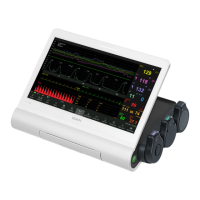F15 Series Fetal & Maternal Monitor User Manual WI-FI Networking and Instructions
- 181 -
occupancy exceeds 50% to ensure that sufficient bandwidth can be used in the channel for the
monitor so as to avoid frequent disconnection and interference.
Therefore, the following principles must be followed for channel settings for multiple sets of
monitors:
1. For the same channel monitor, the physical distance is recommended to be kept above 20m to
ensure mutual interference is minimized.
2. If the same channel number cannot be avoided within the range of 20m, it is necessary to control
the number of monitor of which the same channel number should be no more than 16 units.
3. For monitors within 1m, the channel interval should be set above 2 channels. For example, if the
channel of a monitor is set to 6, then the B monitor needs to be set to channel below 3 or above 9.
4. When using the transducer, ensure that the signal strength of the transducer is above 1 grid (the
signal strength RSSI value is above -65dBm) and the signal strength is greater than the
interference. For installation position of the monitor, test the signal quality in the range that the
hospital wants to cover the monitors, and make sure the signal strength is above 1 grid.
5. At the same time, it is necessary to demand the hospital to ensure there are no Wi-Fi devices that
occupy 50% of the channel for a long time in the surrounding environment.
6. For the network channel number of transducer AP, it should be set more than 3 channels’ interval
from the built-in Wi-Fi network card channel number to avoid mutual interference.
For the Wi-Fi network connected to the central station, it should be noted that the channel number
should be 3 channels’ interval from the AP built-in network, so there are two types of networking:
1 The Wi-Fi networking channel number between all the monitors and the central station can be set
to channel 1, and the AP built-in network is set from channel 6 to ensure that the mutual
interference between the two networks in the monitor is minimized. Similarly, the central station
Wi-Fi networking can be set to channel 13 , and then the AP built-in network channel number can
be set to channel 1~7 . For single monitor channel setup, refer to the previous paragraph, AP
built-in network setup requirements.
For Wi-Fi hotspots, hotspots are placed at intervals. The coverage distance of hotspots is less
than 20m. All hotspots are set to the same channel number to ensure that the interference
between the Wi-Fi network of the central station and the monitor transducer AP network is
minimized. The channels of Wi-Fi modules of all monitors connected to central stations are
unified on one channel. The channel capacity is limited. The amount of data that a single monitor
connecting to the central station is 12 kbps. The number of monitor that can be connected to a
single AP is large, and there are no big communication conflicts.
This scheme is applicable to scenarios where there are many wireless models, central station
network is not frequently used, and there are other Wi-Fi devices in the environment. Other
devices that may interfere can be set near channel 10 to ensure mutual interference is minimized.
2 Considering the interference between the hotspots is the smallest for the Wi-Fi network of the
central station, and the method of cellular network deployment can be adopted. The hotspots of
the Wi-Fi network of the central station adopt the maximum channel spacing, and the interval is
more than 6 with 1, 7, 13 next to each other, the interference of each hot spot can be minimized.
Traditional 510(k) of Fetal & Maternal Monitor
014_14.1_F15_Series_User_Manual

